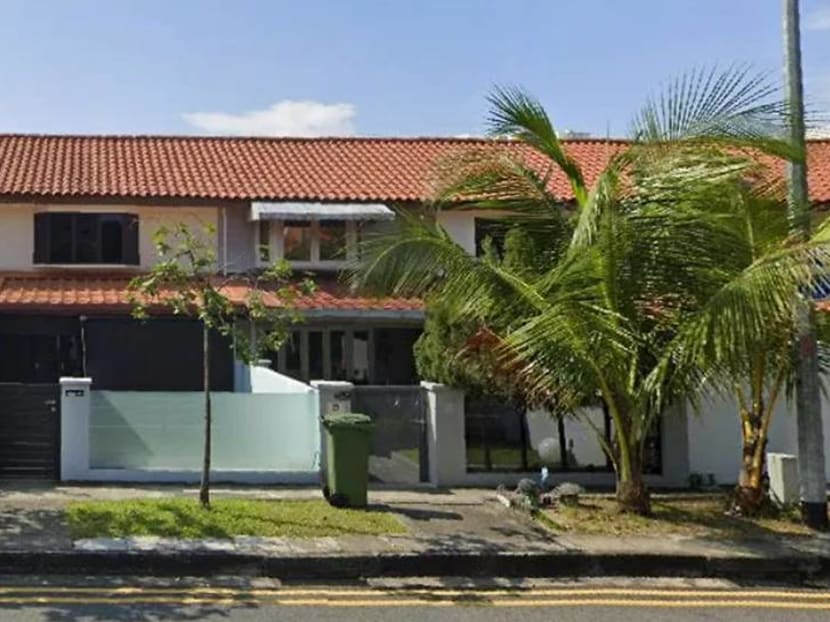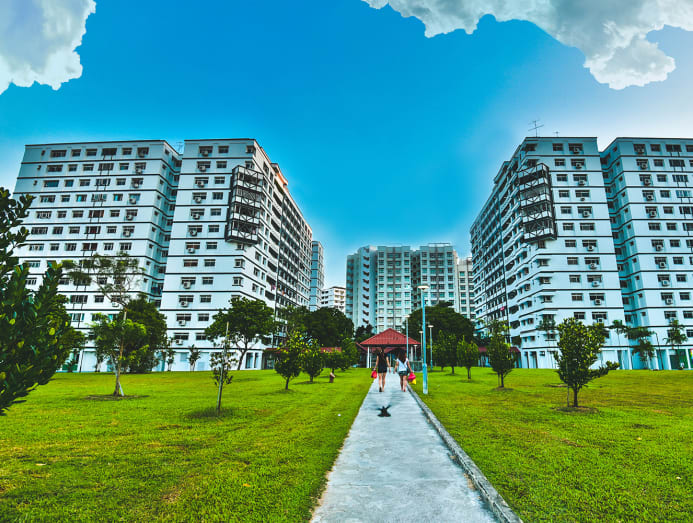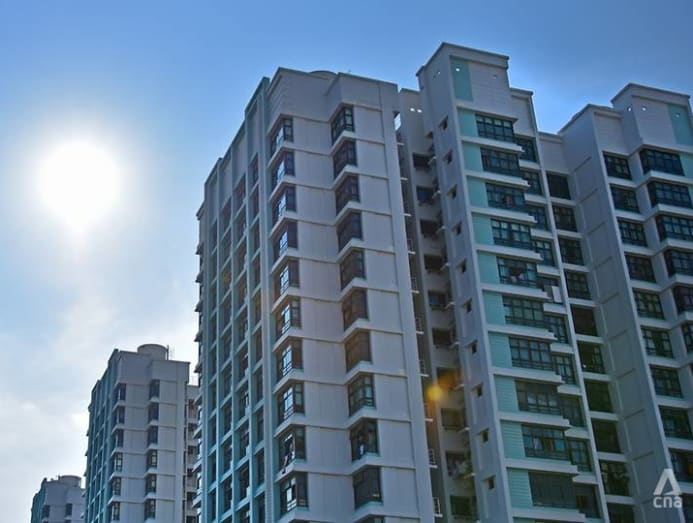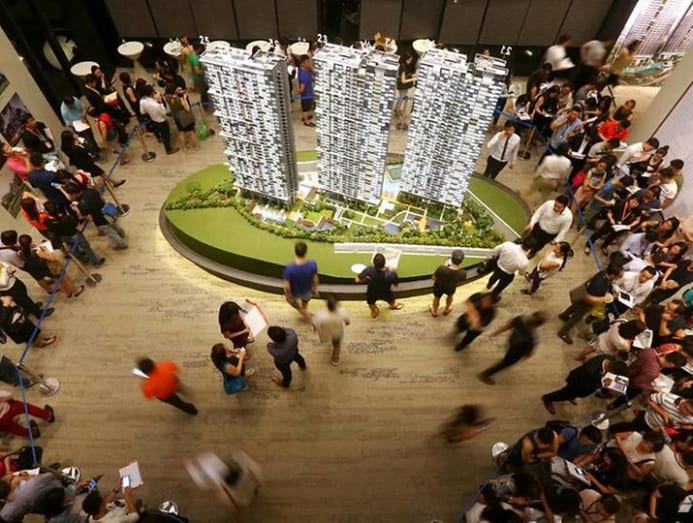Commentary: There is greater demand for bigger homes in a pandemic but will it last?
The last year has shown that small spaces can be tough in the middle of a pandemic, driving demand for bigger homes. How will this change the market? PropNex CEO Ismail Gafoor weighs in.

Modernised front walls of HDB terrace flats in Whampoa. (Photo: Google)
SINGAPORE: They say good things come in small packages.
But when it comes to home sizes, it seems like bigger is better, particularly since the COVID-19 pandemic hit.
Since the end of the circuit breaker in June 2020, we have seen an uptick in interest in larger units, especially in older HDB flats built in the 1980s to 1990s with generous floor areas. Buyers too are on the lookout for larger private homes.
This makes sense when being confined to a limited space with several family members either working-from-home or doing home-based learning - leading many to feel the effects of cabin fever.
READ: Commentary: The future of Singapore housing is in bigger HDB flats
READ: Commentary: When Singapore homes become workspaces – huge changes in the house and beyond
The pandemic has changed the way we live and work, with people waking up to the realisation this indeed may be our new normal and we would have to re-evaluate our space needs and the expanded role the home plays in our lives.
RISE IN DEMAND AND PRICES OF LARGER HDB RESALE FLATS
For the whole of 2020, 5,984 5-room units and 1,882 executive units have been resold, representing a year-on-year increase of 10.3 per cent and 12.8 per cent from 2019.
The pace of increase in the sales of larger flats also exceeded the 4.6 per cent rise in 4-room HDB unit resale over the same period.
READ: Commentary: Is housing still affordable for first-time homeowners?
Meanwhile, the number of 3-room flats resold dipped by 0.7 per cent from 2019 to 2020 – the first annual decline since 2015.
While there was a sharp jump in sales across all flat types from Q2 2020 to Q3 2020, only the 5-room and executive flats managed to book a second straight quarter of growth in Q4 2020, transacting 1,955 units and 640 units respectively.

This comes on the back of three prior consecutive quarters of decline for these two categories of larger HDB homes.
In fact, the demand for executive flats posted the steepest quarter-on-quarter increase of 138.2 per cent in Q3 2020.
While subsequent demand weakened slightly – falling by 3.2 per cent for 5-room flats and 13.3 per cent for executive flats - this easing was due to the high base in the previous quarter, limited availability of larger flats and some price resistance.
To be sure, this strong interest in larger flats, while turbocharged by WFH, is not a new trend. There has been steady demand for 5-room and executive flats since 2014, when their resale volumes have posted year-on-year growth each year, with the exception of 2019.
But clearly this trend has come into sharper focus in 2020. The 10.3 per cent annual growth in resale volume for 5-room flats last year was the largest since the 10.5 per cent increase in 2016, while the 12.8 per cent annual growth in the number of executive flats sold in 2020 was the highest since the 15.5 per cent jump in 2018.
READ: Commentary: If your BTO flat is delayed, staying with parents or in-laws isn’t a bad idea
The average prices per square foot have generally risen too. For instance, the average per square foot price of a 5-room resale flat increased by 5.2 per cent in the last quarter of 2020 and those of executive units rose by over 4 per cent over the last two quarters.
Five-room resale flats also saw the largest compounded average growth rate from 1Q 2017 to 1Q 2021 of about 2.9 per cent.
(We have not looked at sale of larger flats for BTO projects because they tend to be in very selected areas and some applicants drop out during the process.)
SIMILAR SHIFT IN BUYING TREND FOR NEW PRIVATE HOMES
There is a similar trend in the private housing market, with an increase in queries for 3-bedroom units at recent new launches and prospective buyers citing the need for more space for a home office.
In 2020, the sales of new private homes (excluding executive condominiums) with sizes ranging 1,200 sq ft and above rose by about 37 per cent to 1,006 units from 736 units in 2019 - outpacing the 4 per cent increase in sales for units sized below 1,200 sq ft over the same period.

In particular, units spanning 1,200 to 1,600 sq ft have seen a sharper increase in sales in 2020, rising by 54 per cent and 41 per cent year-on-year respectively. These were steeper than the 16 per cent increase units of 600 to 800 sq ft and the 28 per cent for units between 1,000 and 1,200 sq ft last year.
All regional sub-markets across Singapore witnessed a huge jump in sales of larger private homes (1,200 sq ft and up) since the end of the circuit breaker.
DEMAND DRIVERS FOR LARGER HOMES
What’s driving more households to look at larger homes? Couples are looking at the long term and buying larger homes to accommodate a growing family, including the possibility of having elderly parents move in with them.
But as staying home more often might be the new normal with on-off restrictions, lifestyle preference also plays a role as the well-heeled buy a larger unit to create a music room or a library or a yoga studio. Other also knock down walls to enlarge the rooms.
READ: Commentary: How much should young couples spend on their first home?
With homes generally shrinking in size, larger units can become something of a rarity. Five-room flats built between 1990 and 2000 have an average size of 1,300 sq ft, while those built between 2000 and 2010 averaged 1,190 sq ft.
Jumbo flats (typically ranging from 1,442 sq ft to over 1,800 sq ft) are sought-after because the HDB no longer builds them, meaning the supply is fixed at about 2,900 units as at 2017.
That said, in absolute terms, the sales of larger units would still trend below that of small and mid-sized homes mainly on account of affordability. Large homes, with their bigger price tag, may be beyond the budget of many.
WHAT DOES THIS MEAN FOR DEVELOPERS AND BUYERS?
From a housing developer’s perspective, while there is a growing demand for larger units, this increase is not yet significant enough to justify building fewer smaller units and allocating a lot more floor area to larger units, particularly for projects in the city or the city fringe where there tend to be more investors looking at smaller units.
Analysing the sales transactions in the the Core Central Region (CCR) sales of units below 500 sq ft have accounted for a rising proportion of transactions – ticking up to 15.8 per cent of new non-landed home sales in 2020 from 11.8 per cent in 2019 and 7.6 per cent in 2018.

Most buyers are still quantum-sensitive, and developers will still need to offer a diverse range of unit sizes to fit different budgets. Buyers looking for a larger unit but have a tighter budget can, in any case, explore options in the Outside Central Region (OCR) for a private home.
A buyer with a budget of not more than S$1.6 million will be able to purchase a new 1,000 to 1,200 sq ft unit in the OCR, which had an average transacted absolute price of S$1.59 million.
However, that same budget will only be sufficient for new private homes below 800 sq ft in the Rest of Core Region (RCR) and CCR.
To keep units affordable while driving sales, developers may think about introducing other amenities that facilitate WFH.
READ: An 808 sq ft bachelor pad that comes with a cosy gentleman's loft bar
READ: Commentary: Keeping public housing in prime locations like Greater Southern Waterfront affordable and fair
They can offer more efficient and flexible unit layout, provide common co-working spaces and meeting rooms outside homes but within the development, or even a hospitality-style lobby where residents can receive business visitors.
For buyers thinking of getting a larger home, they should work out their sums carefully, because the burden of the monthly mortgage payment can go even higher if interest rates tick up.
Lease decay is another important consideration, especially for buyers looking at older, larger resale properties with a leasehold land tenure.
Ismail Gafoor is CEO of PropNex.





